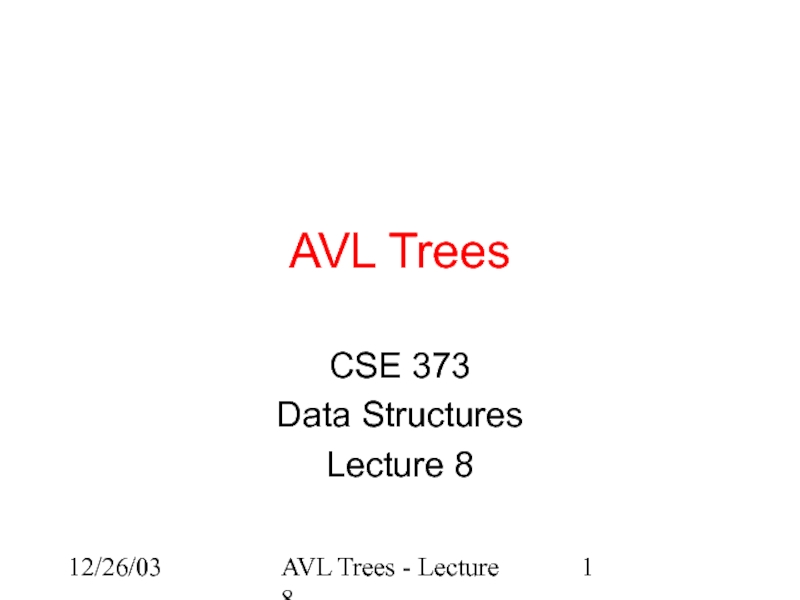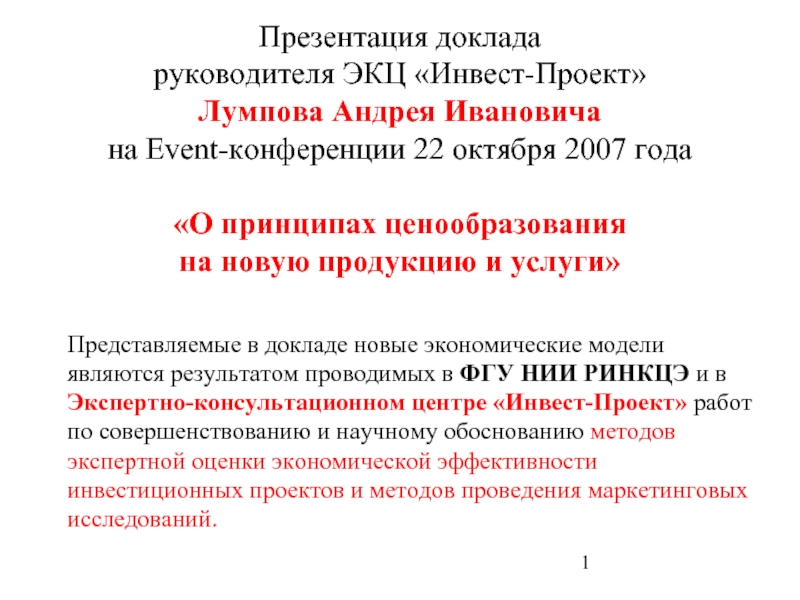- Главная
- Разное
- Дизайн
- Бизнес и предпринимательство
- Аналитика
- Образование
- Развлечения
- Красота и здоровье
- Финансы
- Государство
- Путешествия
- Спорт
- Недвижимость
- Армия
- Графика
- Культурология
- Еда и кулинария
- Лингвистика
- Английский язык
- Астрономия
- Алгебра
- Биология
- География
- Детские презентации
- Информатика
- История
- Литература
- Маркетинг
- Математика
- Медицина
- Менеджмент
- Музыка
- МХК
- Немецкий язык
- ОБЖ
- Обществознание
- Окружающий мир
- Педагогика
- Русский язык
- Технология
- Физика
- Философия
- Химия
- Шаблоны, картинки для презентаций
- Экология
- Экономика
- Юриспруденция
AVL trees. (Lecture 8) презентация
Содержание
- 1. AVL trees. (Lecture 8)
- 2. 12/26/03 AVL Trees - Lecture 8 Readings Reading Section 4.4,
- 3. 12/26/03 AVL Trees - Lecture 8 Binary
- 4. 12/26/03 AVL Trees - Lecture 8 Binary
- 5. 12/26/03 AVL Trees - Lecture 8 Balanced
- 6. 12/26/03 AVL Trees - Lecture 8 Approaches
- 7. 12/26/03 AVL Trees - Lecture 8 Balancing
- 8. 12/26/03 AVL Trees - Lecture 8 Perfect
- 9. 12/26/03 AVL Trees - Lecture 8 AVL
- 10. 12/26/03 AVL Trees - Lecture 8 Height
- 11. 12/26/03 AVL Trees - Lecture 8 Height
- 12. 12/26/03 AVL Trees - Lecture 8 Node
- 13. 12/26/03 AVL Trees - Lecture 8 Node
- 14. 12/26/03 AVL Trees - Lecture 8 Insert
- 15. 12/26/03 AVL Trees - Lecture 8 Single
- 16. 12/26/03 AVL Trees - Lecture 8 Let
- 17. 12/26/03 AVL Trees - Lecture 8
- 18. 12/26/03 AVL Trees - Lecture 8
- 19. 12/26/03 AVL Trees - Lecture 8
- 20. 12/26/03 AVL Trees - Lecture 8
- 21. 12/26/03 AVL Trees - Lecture 8 j
- 22. 12/26/03 AVL Trees - Lecture 8
- 23. 12/26/03 AVL Trees - Lecture 8 Inserting
- 24. 12/26/03 AVL Trees - Lecture 8
- 25. 12/26/03 AVL Trees - Lecture 8 Consider
- 26. 12/26/03 AVL Trees - Lecture 8
- 27. 12/26/03 AVL Trees - Lecture 8
- 28. 12/26/03 AVL Trees - Lecture 8
- 29. 12/26/03 AVL Trees - Lecture 8
- 30. 12/26/03 AVL Trees - Lecture 8 j
- 31. 12/26/03 AVL Trees - Lecture 8 Implementation
- 32. 12/26/03 AVL Trees - Lecture 8 Single
- 33. 12/26/03 AVL Trees - Lecture 8 Double
- 34. 12/26/03 AVL Trees - Lecture 8 Insertion
- 35. 12/26/03 AVL Trees - Lecture 8 Insert
- 36. 12/26/03 AVL Trees - Lecture 8 Insert
- 37. 12/26/03 AVL Trees - Lecture 8 Example
- 38. 12/26/03 AVL Trees - Lecture 8 Example
- 39. 12/26/03 AVL Trees - Lecture 8 Single
- 40. 12/26/03 AVL Trees - Lecture 8 Double
- 41. 12/26/03 AVL Trees - Lecture 8 AVL
- 42. 12/26/03 AVL Trees - Lecture 8 Arguments
- 43. 12/26/03 AVL Trees - Lecture 8 Double
Слайд 312/26/03
AVL Trees - Lecture 8
Binary Search Tree - Best Time
All BST
minimum d is for a binary tree with N nodes
What is the best case tree?
What is the worst case tree?
So, best case running time of BST operations is O(log N)
Слайд 412/26/03
AVL Trees - Lecture 8
Binary Search Tree - Worst Time
Worst case
What happens when you Insert elements in ascending order?
Insert: 2, 4, 6, 8, 10, 12 into an empty BST
Problem: Lack of “balance”:
compare depths of left and right subtree
Unbalanced degenerate tree
Слайд 512/26/03
AVL Trees - Lecture 8
Balanced and unbalanced BST
4
2
5
1
3
1
5
2
4
3
7
6
4
2
6
5
7
1
3
Is this “balanced”?
Слайд 612/26/03
AVL Trees - Lecture 8
Approaches to balancing trees
Don't balance
May end up
Strict balance
The tree must always be balanced perfectly
Pretty good balance
Only allow a little out of balance
Adjust on access
Self-adjusting
Слайд 712/26/03
AVL Trees - Lecture 8
Balancing Binary Search Trees
Many algorithms exist for
Adelson-Velskii and Landis (AVL) trees (height-balanced trees)
Splay trees and other self-adjusting trees
B-trees and other multiway search trees
Слайд 812/26/03
AVL Trees - Lecture 8
Perfect Balance
Want a complete tree after every
tree is full except possibly in the lower right
This is expensive
For example, insert 2 in the tree on the left and then rebuild as a complete tree
Insert 2 &
complete tree
6
4
9
8
1
5
5
2
8
6
9
1
4
Слайд 912/26/03
AVL Trees - Lecture 8
AVL - Good but not Perfect Balance
AVL
Balance factor of a node
height(left subtree) - height(right subtree)
An AVL tree has balance factor calculated at every node
For every node, heights of left and right subtree can differ by no more than 1
Store current heights in each node
Слайд 1012/26/03
AVL Trees - Lecture 8
Height of an AVL Tree
N(h) = minimum
Basis
N(0) = 1, N(1) = 2
Induction
N(h) = N(h-1) + N(h-2) + 1
Solution (recall Fibonacci analysis)
N(h) > φh (φ ≈ 1.62)
h-1
h-2
h
Слайд 1112/26/03
AVL Trees - Lecture 8
Height of an AVL Tree
N(h) > φh
Suppose we have n nodes in an AVL tree of height h.
n > N(h) (because N(h) was the minimum)
n > φh hence logφ n > h (relatively well balanced tree!!)
h < 1.44 log2n (i.e., Find takes O(logn))
Слайд 1212/26/03
AVL Trees - Lecture 8
Node Heights
1
0
0
2
0
6
4
9
8
1
5
1
height of node = h
balance factor
empty height = -1
0
0
height=2 BF=1-0=1
0
6
4
9
1
5
1
Tree A (AVL)
Tree B (AVL)
Слайд 1312/26/03
AVL Trees - Lecture 8
Node Heights after Insert 7
2
1
0
3
0
6
4
9
8
1
5
1
height of node
balance factor = hleft-hright
empty height = -1
1
0
2
0
6
4
9
1
5
1
0
7
0
7
balance factor
1-(-1) = 2
-1
Tree A (AVL)
Tree B (not AVL)
Слайд 1412/26/03
AVL Trees - Lecture 8
Insert and Rotation in AVL Trees
Insert operation
only nodes on the path from insertion point to root node have possibly changed in height
So after the Insert, go back up to the root node by node, updating heights
If a new balance factor (the difference hleft-hright) is 2 or –2, adjust tree by rotation around the node
Слайд 1612/26/03
AVL Trees - Lecture 8
Let the node that needs rebalancing be
There are 4 cases:
Outside Cases (require single rotation) :
1. Insertion into left subtree of left child of α.
2. Insertion into right subtree of right child of α.
Inside Cases (require double rotation) :
3. Insertion into right subtree of left child of α.
4. Insertion into left subtree of right child of α.
The rebalancing is performed through four
separate rotation algorithms.
Insertions in AVL Trees
Слайд 1712/26/03
AVL Trees - Lecture 8
j
k
X
Y
Z
Consider a valid
AVL subtree
AVL Insertion: Outside Case
h
h
h
Слайд 1812/26/03
AVL Trees - Lecture 8
j
k
X
Y
Z
Inserting into X
destroys the AVL
property at
AVL Insertion: Outside Case
h
h+1
h
Слайд 2112/26/03
AVL Trees - Lecture 8
j
k
X
Y
Z
“Right rotation” done!
(“Left rotation” is mirror
Outside Case Completed
AVL property has been restored!
h
h+1
h
Слайд 2312/26/03
AVL Trees - Lecture 8
Inserting into Y
destroys the
AVL property
at node
j
k
X
Y
Z
AVL Insertion: Inside Case
Does “right rotation”
restore balance?
h
h+1
h
Слайд 2412/26/03
AVL Trees - Lecture 8
j
k
X
Y
Z
“Right rotation”
does not restore
balance… now k is
out
AVL Insertion: Inside Case
h
h+1
h
Слайд 2512/26/03
AVL Trees - Lecture 8
Consider the structure
of subtree Y…
j
k
X
Y
Z
AVL Insertion: Inside
h
h+1
h
Слайд 2612/26/03
AVL Trees - Lecture 8
j
k
X
V
Z
W
i
Y = node i and
subtrees V and
AVL Insertion: Inside Case
h
h+1
h
h or h-1
Слайд 2712/26/03
AVL Trees - Lecture 8
j
k
X
V
Z
W
i
AVL Insertion: Inside Case
We will do a
“double rotation” . . .
Слайд 2912/26/03
AVL Trees - Lecture 8
j
k
X
V
Z
W
i
Double rotation : second rotation
Now do a
Слайд 3012/26/03
AVL Trees - Lecture 8
j
k
X
V
Z
W
i
Double rotation : second rotation
right rotation complete
Balance
restored
h
h
h or h-1
Слайд 3112/26/03
AVL Trees - Lecture 8
Implementation
balance (1,0,-1)
key
right
left
No need to keep the height;
Once you have performed a rotation (single or double) you won’t need to go back up the tree
Слайд 3212/26/03
AVL Trees - Lecture 8
Single Rotation
RotateFromRight(n : reference node pointer) {
p
p := n.right;
n.right := p.left;
p.left := n;
n := p
}
X
Y
Z
n
You also need to modify the heights or balance factors of n and p
Insert
Слайд 3312/26/03
AVL Trees - Lecture 8
Double Rotation
Implement Double Rotation in two lines.
DoubleRotateFromRight(n
????
}
X
n
V
W
Z
Слайд 3412/26/03
AVL Trees - Lecture 8
Insertion in AVL Trees
Insert at the leaf
only nodes on the path from insertion point to root node have possibly changed in height
So after the Insert, go back up to the root node by node, updating heights
If a new balance factor (the difference hleft-hright) is 2 or –2, adjust tree by rotation around the node
Слайд 3512/26/03
AVL Trees - Lecture 8
Insert in BST
Insert(T : reference tree pointer,
if T = null then
T := new tree; T.data := x; return 1;//the links to //children are null
case
T.data = x : return 0; //Duplicate do nothing
T.data > x : return Insert(T.left, x);
T.data < x : return Insert(T.right, x);
endcase
}
Слайд 3612/26/03
AVL Trees - Lecture 8
Insert in AVL trees
Insert(T : reference tree
if T = null then
{T := new tree; T.data := x; height := 0; return;}
case
T.data = x : return ; //Duplicate do nothing
T.data > x : Insert(T.left, x);
if ((height(T.left)- height(T.right)) = 2){
if (T.left.data > x ) then //outside case
T = RotatefromLeft (T);
else //inside case
T = DoubleRotatefromLeft (T);}
T.data < x : Insert(T.right, x);
code similar to the left case
Endcase
T.height := max(height(T.left),height(T.right)) +1;
return;
}
Слайд 3712/26/03
AVL Trees - Lecture 8
Example of Insertions in an AVL Tree
1
0
2
20
10
30
25
0
35
0
Insert
Слайд 3812/26/03
AVL Trees - Lecture 8
Example of Insertions in an AVL Tree
1
0
2
20
10
30
25
1
35
0
5
0
20
10
30
25
1
35
5
40
0
0
0
1
2
3
Now
Слайд 3912/26/03
AVL Trees - Lecture 8
Single rotation (outside case)
2
0
3
20
10
30
25
1
35
2
5
0
20
10
30
25
1
40
5
40
0
0
0
1
2
3
45
Imbalance
35
45
0
0
1
Now Insert 34
Слайд 4012/26/03
AVL Trees - Lecture 8
Double rotation (inside case)
3
0
3
20
10
30
25
1
40
2
5
0
20
10
35
30
1
40
5
45
0
1
2
3
Imbalance
45
0
1
Insertion of 34
35
34
0
0
1
25
34
0
Слайд 4112/26/03
AVL Trees - Lecture 8
AVL Tree Deletion
Similar but more complex than
Rotations and double rotations needed to rebalance
Imbalance may propagate upward so that many rotations may be needed.
Слайд 4212/26/03
AVL Trees - Lecture 8
Arguments for AVL trees:
Search is O(log N)
Insertion and deletions are also O(logn)
The height balancing adds no more than a constant factor to the speed of insertion.
Arguments against using AVL trees:
Difficult to program & debug; more space for balance factor.
Asymptotically faster but rebalancing costs time.
Most large searches are done in database systems on disk and use other structures (e.g. B-trees).
May be OK to have O(N) for a single operation if total run time for many consecutive operations is fast (e.g. Splay trees).
Pros and Cons of AVL Trees
Слайд 4312/26/03
AVL Trees - Lecture 8
Double Rotation Solution
DoubleRotateFromRight(n : reference node pointer)
RotateFromLeft(n.right);
RotateFromRight(n);
}
X
n
V
W
Z
















































